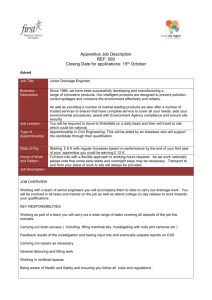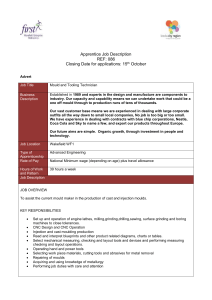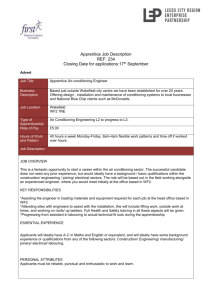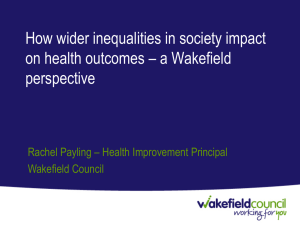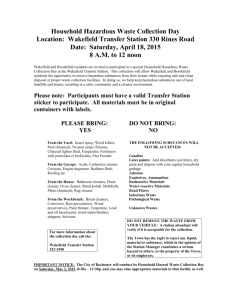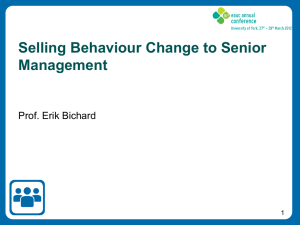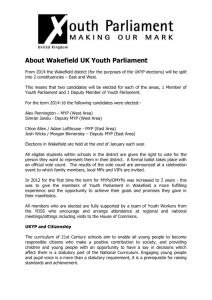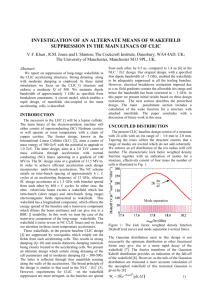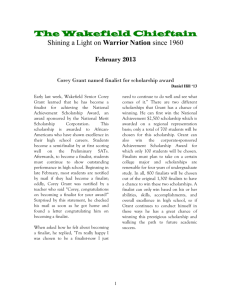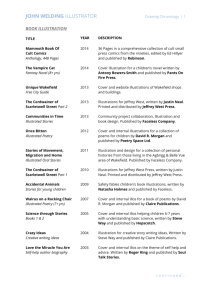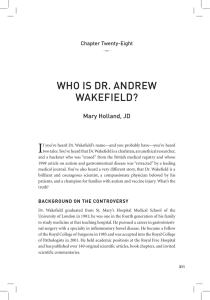EGR/STHV108S Final Examination
advertisement
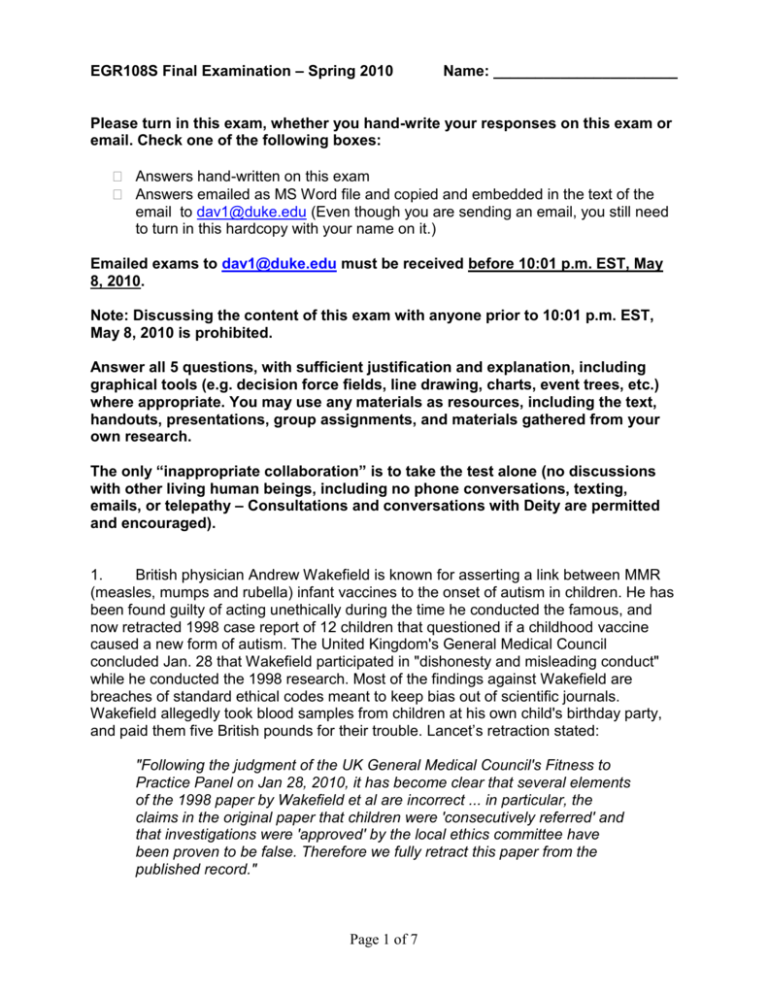
EGR108S Final Examination – Spring 2010 Name: ______________________ Please turn in this exam, whether you hand-write your responses on this exam or email. Check one of the following boxes: Answers hand-written on this exam Answers emailed as MS Word file and copied and embedded in the text of the email to dav1@duke.edu (Even though you are sending an email, you still need to turn in this hardcopy with your name on it.) Emailed exams to dav1@duke.edu must be received before 10:01 p.m. EST, May 8, 2010. Note: Discussing the content of this exam with anyone prior to 10:01 p.m. EST, May 8, 2010 is prohibited. Answer all 5 questions, with sufficient justification and explanation, including graphical tools (e.g. decision force fields, line drawing, charts, event trees, etc.) where appropriate. You may use any materials as resources, including the text, handouts, presentations, group assignments, and materials gathered from your own research. The only “inappropriate collaboration” is to take the test alone (no discussions with other living human beings, including no phone conversations, texting, emails, or telepathy – Consultations and conversations with Deity are permitted and encouraged). 1. British physician Andrew Wakefield is known for asserting a link between MMR (measles, mumps and rubella) infant vaccines to the onset of autism in children. He has been found guilty of acting unethically during the time he conducted the famous, and now retracted 1998 case report of 12 children that questioned if a childhood vaccine caused a new form of autism. The United Kingdom's General Medical Council concluded Jan. 28 that Wakefield participated in "dishonesty and misleading conduct" while he conducted the 1998 research. Most of the findings against Wakefield are breaches of standard ethical codes meant to keep bias out of scientific journals. Wakefield allegedly took blood samples from children at his own child's birthday party, and paid them five British pounds for their trouble. Lancet’s retraction stated: "Following the judgment of the UK General Medical Council's Fitness to Practice Panel on Jan 28, 2010, it has become clear that several elements of the 1998 paper by Wakefield et al are incorrect ... in particular, the claims in the original paper that children were 'consecutively referred' and that investigations were 'approved' by the local ethics committee have been proven to be false. Therefore we fully retract this paper from the published record." Page 1 of 7 "In some ways I think it's irrelevant," said Dr. Paul Offit, chief of the Section of Infectious Diseases at Children's Hospital of Philadelphia, as reported by ABC News. Offit has been twice threatened with lawsuits for critical statements he has made of Wakefield's work. Offit’s contention is that Wakefield’s " hypothesis was that by combining the MMR into a single shot that it was somehow weakening the immune system, causing the measles part of the vaccine to travel to the gut and cause damage" and that the damage could travel into the bloodstream and damage the brain – hence the link to autism. This hypothesis led to advocacy groups concern and calls for actions and who rallied for Wakefield and released press statements declaring that his theories have led, even if anecdotally, to successful treatment in their children. Most biomedical scientists contend Wakefield's hypothesis has long been refuted by large studies. ABC news has reported that these scientists may be interested in the ethical breaches of Wakefield, but not relevant to the debate. The upshot of Wakefield’s hypothesis was that increasingly parents avoided the vaccines, with the percentage of unvaccinated U.S. children rising from 0.77 percent in 1997 to 2.1 percent in 2000. Similar declines took place in Britain, thus leading to weakened immune systems and increased childhood risk for very serious diseases. The U.S. Centers for Disease Control had declared U.S. free of measles in 2000, but the decrease in vaccinations brought back a 2008 outbreak. Consider this case from various ethical perspectives and linking cause to effects (e.g. Hill’s Criteria, risk, reliability). Describe the lessons this case can provide to professionals regarding ethical obligations. Page 2 of 7 2. The Belmont Report expressed the principles of respect for persons, justice, and beneficence. Describe two instances when these have not been upheld by researchers and the role of professional(s), especially in adherence to the credos of credat emptor and ethike aretai, and other measures of morality. Page 3 of 7 3. Health care providers have been shown to be reticent in describing the withholding of food and water to patients where treatment has been deemed to be futile, in fact saying that they are not ending that person’s life. How does this relate to Snow’s contention that "the only ethical principle which has made science possible is that the truth shall be told all the time” or to Feynman’s admonition that “you must not fool yourself – and you are the easiest person to fool”? If the healthcare providers justify the withholding of non-extraordinary means in order to free up some beds, would this violate the double effect principle, the harm principle, the categorical imperative or the veil of ignorance? Explain. Page 4 of 7 4. Choose five of the following. Write a syllogism and draw a decision force field describing the moral conclusion you have reached regarding each: Toyota braking problem Vioxx side effects China’s one child rule Physician assisted suicide and euthanasia Product labeling only in English Late term abortion Improved land mines Pharmacists’ refusal to fill morning after prescriptions Use of performance enhancing drugs Designer children Large lot zoning and fairness Embryonic stem cell research Cord blood and amniotic stem cell research In vitro fertilization Exxon Valdes Therac-25 Yucca Mountain nuclear waste disposal Coma/”PVS” cases, including Schiavo Confined animal feeding operations “ClimateGate” Therapeutic misconception Heinz’s dilemma Homeless people, e.g. the Good Samaritan in NYC Precaution versus evidence-based decision making The Yes Men’s methods Johnson & Johnson and the Tylenol tempering case Bhopal’s toxic cloud and its aftermath Drug advertizing and conflict of interest Government’s response to Agent Orange health problems Banning DDT Manipulation of medical information to “game” Medicare Offsetting behaviors Animal rights Legal standing of a tree Excessive plastic surgery and role of physician Withholding medical treatment for religious reasons Love Canal and Times Beach Page 5 of 7 5. Give an example and explain how you have used the tools, homework, group discussions and other lessons learned from this course in making or analyzing a moral decision? Please disclose only information you are comfortable sharing broadly. Page 6 of 7 END OF EXAM Page 7 of 7
